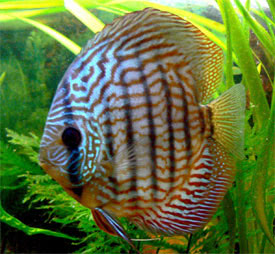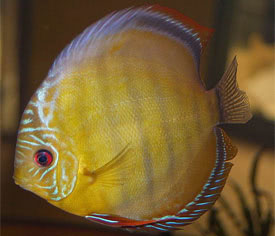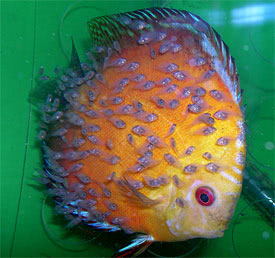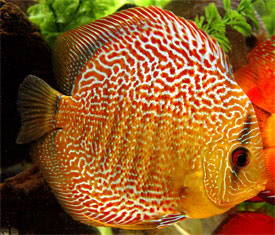Symphysodon aequifasciatus - Discus fish
 Magyarul / Hungarian
Magyarul / Hungarian

 Magyarul / Hungarian
Magyarul / Hungarian




- Scientific name: Symphysodon aequifasciatus
- Common name: Discus fish
- Group: Cichlids
- Habitat: South America; Amazon Basin.
- Size: 20 cm.
- Biotope: Sections of deep, calm water with submerged trees in clear and White water in Amazonia The fish live in groups among the branches of these trees.
- Social behavior:Discus are calm, timid fish who like to be kept in small groups of 6-8 fish. There is much debate to whether discus should be kept in community tanks or in species tanks. Since Discus coexist with other fish in nature, they can be kept with other peaceful fish. Discus feel more comfortable if combined with small schooling fish such as characins. When the discus see the characins in the open, they are likely to come out, sensing that they are safe to swim. Adult Discus may eat small fish if not brought up with small fish. Take care when combining Discus with greedy feeders such as Angelfish, and Discus may not be able to compete.
- Diet: Provide a large variety of live, dry, and frozen foods. Try to feed Discus as many nutritional foods as possible such as fortified flake foods, water insects, and brine shrimp.
- Breeding: Hard.
- Tank: Minimum 200 litres
- Population: 7-8 fishes for 500-600 litres
- Decoration: Roots, driftwood, and heavy vegetation should be used to provide hiding places. Open swimming areas should be created. A good filter for removing wastes is essential in Discus care.
- Temperature: 28-30°C
- pH: 5-8
- Hardness: 0-12 NK°
- Lifespan: 10 years
Description: Almost circular, or orb shaped with strong lateral compression. Small mouthed with a steep rising forehead. Dorsal and Anal fins are rounded with a long base. Caudal fin is indented and the Ventral fins are saber shaped.
Today the different colors of the Discus can rival any marine fish. All of the new and exciting fish we have today came from pretty but not awe inspiring stock. In the wild this species has three subspecies which are distinguished by their coloration. Most of our beautiful variations have been breed from these original fish.
Hasonló vízparamétereket igénylő fajok


